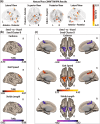Resting-state functional connectivity correlates of gait and turning performance in multiple sclerosis: a multivariate pattern analysis
- PMID: 41115952
- PMCID: PMC12537983
- DOI: 10.1038/s41598-025-21102-6
Resting-state functional connectivity correlates of gait and turning performance in multiple sclerosis: a multivariate pattern analysis
Abstract
Multiple sclerosis (MS) often leads to mobility impairments, yet the neural mechanisms underlying these deficits remain poorly understood. This study examined whether resting-state functional connectivity (rs-FC) differs between people with MS (PwMS) and healthy controls in relation to spatiotemporal mobility performance. We hypothesized that group differences within the default mode (DMN), frontoparietal (FPN), somatomotor (SN), and visual (VIS) networks would be associated with gait and turning metrics. Twenty-nine PwMS and 28 matched controls completed a two-minute walk test, 180° walking turns, and 360° in-place turns at natural and fast speeds. fMRI data were analyzed using multivariate pattern analysis (MVPA) and post-hoc seed-to-voxel analyses for gait speed, cadence, double support time, stride length, turn duration, peak velocity, and turn angle. PwMS exhibited slower gait speed, shorter stride length, and impaired 360° turning, but no group differences in cadence, double support, or 180° turn metrics. MVPA revealed rs-FC differences across DMN, FPN, SN, and VIS networks. While rs-FC differences were evident for walking metrics, within-group associations were not significant. In contrast, 360° turn angle showed distinct within-group rs-FC associations, particularly involving VAN and DAN networks. These findings highlight turning as a sensitive task for capturing functional neural differences in MS.
Keywords: Gait performance; Multiple sclerosis (MS); Multivariate pattern analysis (MVPA); Neural network connectivity; Resting-state functional connectivity; Turning kinematics.
© 2025. This is a U.S. Government work and not under copyright protection in the US; foreign copyright protection may apply.
Conflict of interest statement
Declarations. Competing interests: The authors declare no competing interests.
Figures





References
-
- Richmond, S. B., Swanson, C. W., Peterson, D. S. & Fling, B. W. A temporal analysis of bilateral gait coordination in people with multiple sclerosis. Multiple Scler. Relat. Disorders. 45, 102445 (2020). - PubMed
-
- Richmond, S. B. & Fling, B. W. Transcallosal control of bilateral actions. Exerc. Sport Sci. Rev.47 (4), 251–257 (2019). - PubMed
-
- Motl, R. W. & Learmonth, Y. C. Neurological disability and its association with walking impairment in multiple sclerosis: brief review. Neurodegener. Dis. Manag.4 (6), 491–500 (2014). - PubMed
MeSH terms
Grants and funding
LinkOut - more resources
Full Text Sources
Medical
Miscellaneous

